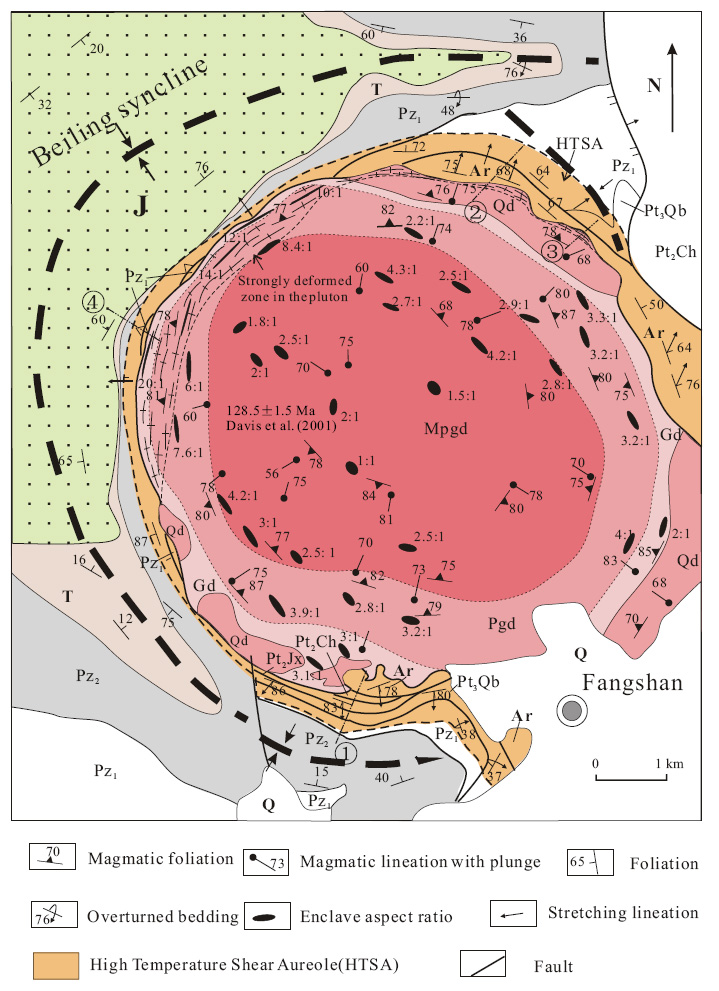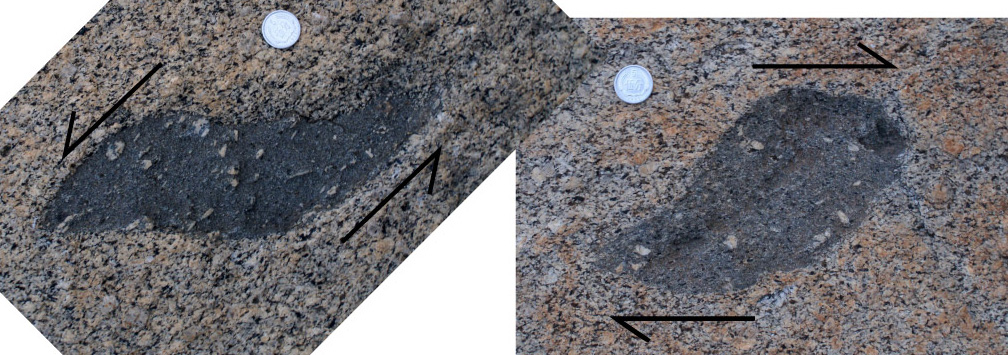Emplacement-related structures in the Fangshan diapir, North China Craton
Roberto Weinberg, Monash University, Australia
He Bin, Guangzhou Institute of Geochemistry, Guangzhou, China
 from Bin He et. al.
|
 |
| EMPLACEMENT HISTORY OF
THE FENGSHANG PLUTON a) stable, consistent regional stratigraphy of the N China Craton, with formation thickness constant or gradually varying over large areas, b) low metamorphic grade away from the pluton margins, increasing towards the pluton, c) Archean not normally exposed elsewhere, and nowhere in the broader area surrounding the Fengshan pluton (radius of > 100 km). |
a) Northern contact
b) Southern contact
c) Western contact (Oct 27: SW, and Oct 30-31: NW-N)
d) Northeastern contact (Oct 28)
a) NORTHERN MARGIN OF FANGSHAN PLUTON (Dang Ling Zi village)
NORTHERN MARGIN DEFORMATION PHASE 1: STEEP, PENETRATIVE THRUSTING ONTO PLUTON.
NORTHERN MARGIN DEFORMATION PHASE 2: LOCALIZED THRUSTING ONTO PLUTON
NORTHERN MARGIN DEFORMATION PHASE 2: LOCALIZED THRUSTING ONTO PLUTON
NORTHERN MARGIN DEFORMATION PHASE 3: PLUTON UP
| b) SOUTHERN MARGIN
DEFORMATION PHASE 1 (Oct 25 and Oct 27):
STEEP, PENETRATIVE THRUSTING ONTO PLUTON Like the northern margin, the pluton here is in contact with Archean rocks which record thrusting to the N (S-side-up) onto the pluton, corresponding to DEFORMATION PHASE 1. We have not documented any other deformation phase, but only a limited section of contact rocks were studied close to the water purification plant.0 |
| c) WESTERN MARGIN OF
FANGSHAN PLUTON: STRIKE SLIP
There are many differences between the western margin and the northern and southern margins. i) western margin contact is porphyritic granodiorite, instead of quartz-diorite (or gabbro in north) ii) contact rocks on the west is Carboniferous-Permian instead of Archean-Proterozoic iii) strike-slip syn-magmatic deformation on the west, compared to a dominantly dip-slip iv) enclaves are more stretched, and there are a number of broken-up syn-magmatic mafic dykes in the west v) no rim syncline on the west side. We visited several outcrops along this western margin, all had parvasive conjugate deformation dextral-sinistral with a small acute angle between them of the order of 50 degrees. The orientation of the C-planes rotated approximately 100 degrees counter-clockwise from NW to SE, defining an arc with maximum shortening perpendicular to the contact indicative of ballooning. Deformation most likely started at super-solidus state and continued at sub- solidus conditions, as indicated by the deformation of enclaves and dykes. Walking south along the contact, the strikes of the different shear planes rotate anticlockwise (these are based on a few but consistent orientations): NW quarry area N39 45' 40.1" E115 55' 55.0" C-sin= 230-240 C-dex= 100 S=70-80 W at the cwm up the valley N39 45' 13.7"N E115 55' 07.4" C-sin= 05-10 C-dex= 55-70 S=30-40 SW close to Che Chang village N39 44' 36.4" E115 54' 52.0" C-sin =330 C-dex=000 -010 S= 350 |
Southwest margin: Close to Che Chang village 39 44' 36.4"N 115 54' 52.0"
| Figure 6a) Dextral asymmetry in enclave in granodiorite (Click here for a page on enclaves at Fangshan). Horizontal outcrop surface. The enclave started to break-up parallel to the S-plane of dextral deformation while still a magmatic mush. In this outcrop, C-plane of dextral shearing strikes N-S/steep dip, lineation on granodiorite is 20 to N. Rocks record a second deformation, most likely a late overpriting, sinstral trending 335/steep. In this outcrop, leucocratic dykes with diffuse margin with the granodiorite and narrow diffuse tips into the country rock suggesting local segregation, trend at a high angle to both C-planes, varying 30 degrees around E-W (ph 4163 not shown here, statistical data required). | Figure 6b) Same as (a). Enclaves in this area in general show a dextral asymmetry, indicative of an early dominance of dextral deformation. | Figure 6c) Late brittle displacement of enclaves (Click here for a page on enclaves at Fangshan). |
Northwest to west margin: 39 45' 40.1"N 115 55' 55.0" (track of quarry company).
 Figure 7a) Enclave asymmetry indicative of both sinistral and dextral shearing (Click here for a page on enclaves at Fangshan). Original distance between enclaves: 1-2m. The conjugate nature of shearing is expressed in S-C fabric throughout the ouctrop. Sinistral C-plane striking 230-240, dextral C-plane striking 100, with a common S-plane approximately striking 100. The conjugate pair here is rotated by approximately compared with the previous locality (Che Chang village) |
Figure 8a) Dextral shear in granodiorite (notice S-C fabric and deformed feldspar phenocrysts). The tip of the enclave is thinned out and bent into a high strain zone. Otherwise the changes in bulk strain are not visible. |
Figure 8b) Penetrative sinistral S-C fabric in granodiorite with enclave (possible a broken up section of a dyke). Shear becomes localized into narrow fault bands displacing and deforming the tip of the enclave. Click here for more on enclaves at Fangshan. |
Figure 9a) Fish-shaped enclave indicative of dextral shearing in granodiorite (upper part of the photograph). On the lower part, a 10 cm thick mylonite with sharp boundaries against weakly deformed granodiorite. Mylonite is parallel to the C-plane in the the sheared granodiorite, and asymmetries in the mylonite are indicative of dextral shearing. Click here for more on enclaves at Fangshan |
| d) NORTHEASTERN MARGIN
OF FANGSHAN PLUTON: THRUST AND
STRIKE-SLIP (OCT 28)
Dong Kiu Shui village, 39 45' 00"N and 115 59' 00"E, Qz-diorite quarry close to Archean contact. This region shares similarities with both north side and the W-side, suggesting transitional behaviour between dip-slip and strike-slip domains. The penetrative foliation is a result of dextral shearing with a thrust component up towards the pluton, on C=350-360 / 30-60 E, and L= 030/20-30 (another measurement 038/08) on C=017/48E. Interpreted as the equivalent of Deformation Phases 1 which becomes more localized (Phase 2). Overprinted(?) by a vertical foliation striking 300-330, defined by biotite alignment with very clear NE-side-down (pluton-up) shear sense (Deformation phase 3). Contact with Archean ultramylonitic granites is gently dipping, and rocks contain epidote-rich cm bands like on the south side (contact 345/32 NE, L=022/08 dextral shear fabric. |